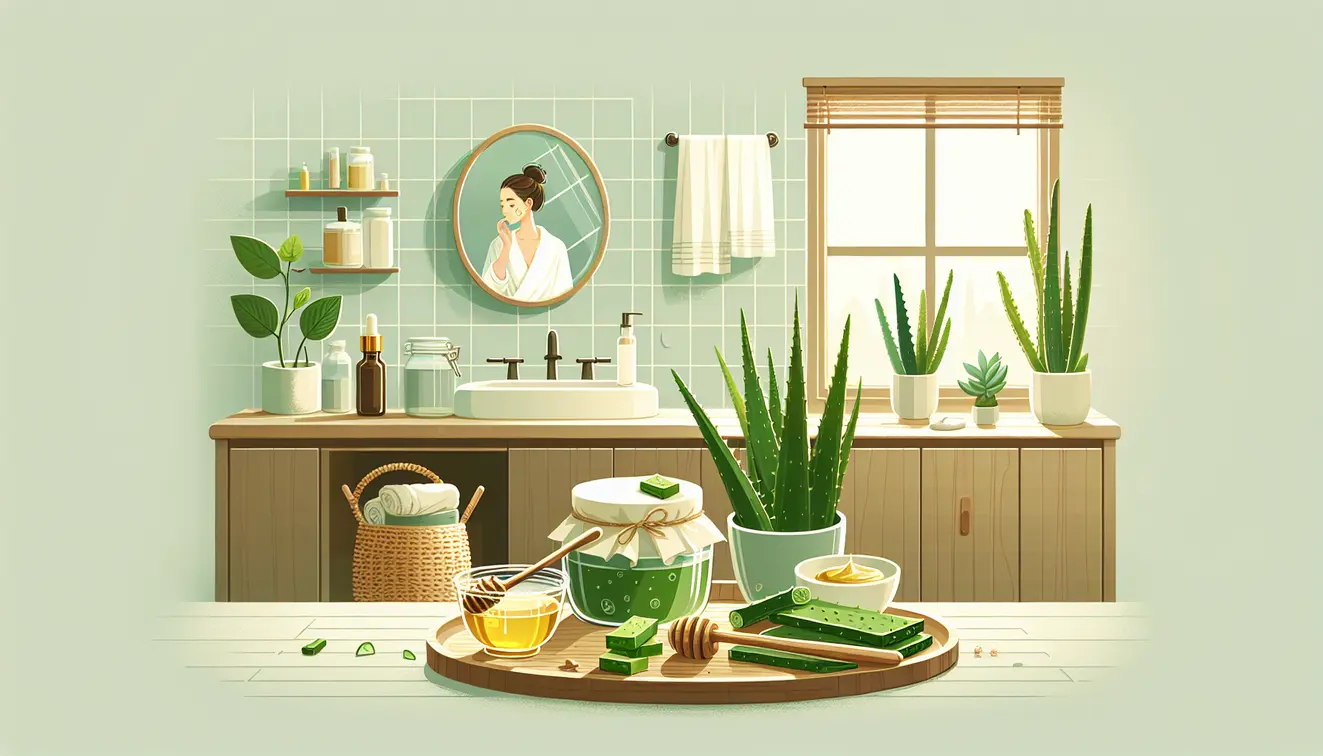Home Remedies for Pimples: Your Natural Guide to Clear Skin in 2025
Estimated reading time: 8 minutes
Key Takeaways
- Natural remedies like tea tree oil and honey can effectively manage mild to moderate acne with minimal side effects.
- Understanding pimple causes—hormones, stress, and diet—helps target treatments for better results.
- Consistency in a skincare routine using home remedies can show results in 2-4 weeks.
- Safety first: Always patch test and tailor remedies to your skin type to avoid irritation.
- Lifestyle tweaks, including diet and stress management, boost the power of natural acne solutions.
Table of Contents
- Introduction to Pimples and the Power of Natural Remedies
- What Causes Pimples? Understanding the Root Issues
- Top 10 Evidence-Based Home Remedies for Pimples
- Building a Skincare Routine with Home Remedies
- Safety Tips and Precautions for Using Natural Remedies
- Lifestyle Changes to Prevent Pimples Naturally
- How Long Until You See Results with Home Remedies?
- Home Remedies vs. Over-the-Counter Treatments
- Frequently Asked Questions (FAQs)
Introduction to Pimples and the Power of Natural Remedies
Welcome to Wiki Home Remedies, where we empower you with safe, science-backed solutions to everyday health concerns. If pimples have been dimming your confidence, you’re not alone. This guide is here to walk you through natural ways to achieve clearer skin in 2025, harnessing nature’s healing power with practical, trusted advice.
Pimples, those pesky red spots, affect millions worldwide, often showing up at the worst times. According to the American Academy of Dermatology, nearly 85% of people experience acne at some point, making it a shared struggle across ages. Whether it’s a single blemish or stubborn breakouts, the frustration is real, often tied to hormones, stress, or even diet.
Why turn to natural remedies in 2025? Many seek gentler options that work without harsh effects, embracing ingredients straight from the earth. These solutions often cost less and sit right in your kitchen or local store, offering relief with minimal risk. Studies, including those from the National Institutes of Health (NIH), highlight a rising interest in natural skincare, showing effectiveness for mild to moderate acne when used wisely.
At Wiki Home Remedies, our mission is delivering evidence-based, accessible paths to wellness. We’ve crafted this guide to help you understand pimples and tackle them naturally, drawing from reputable research and real-life insights. Let’s explore what sparks these breakouts and how nature can guide you to smoother skin.
What Causes Pimples? Understanding the Root Issues
Pimples don’t just appear out of nowhere—they’re often a mix of internal and external culprits. Inside your skin, pores get clogged with oil and dead cells, creating a perfect spot for bacteria to thrive. Outside, your daily habits or surroundings can nudge these blemishes to the surface, making it vital to know the triggers.
Let’s break it down further to see why your skin might be acting up. By understanding the roots, you’ll be better armed to choose remedies that truly target the issue. From hormones to lifestyle, credible sources like the Mayo Clinic underline the complexity of acne, and we’re here to clarify it for you.
Biological Factors Behind Pimples
Your body plays a big role in acne. Hormonal shifts, especially during teen years or life changes like pregnancy, ramp up oil production, clogging pores. Research shows that a bacterium called Propionibacterium acnes feeds on this oil, sparking inflammation and those familiar red bumps.
These hormonal peaks often hit hardest in adolescence, but adults aren’t spared either. Studies indicate that women, in particular, may notice breakouts tied to monthly cycles. Knowing this link can help you anticipate and manage flare-ups with care.
Lifestyle and Environmental Triggers
Beyond biology, how you live impacts your skin. Stress, for instance, can worsen breakouts—in fact, dermatology journals suggest it’s linked to half of all acne flares. Then there’s diet; high-glycemic foods or dairy might nudge oil glands into overdrive for some.
Your surroundings matter too. Humidity can trap sweat and oil on your face, while poor hygiene lets buildup settle in pores. Think of a stressful exam week—late nights and worry often bring a pimple or two. Recognizing these factors lets you adjust and protect your skin.
Common Myths About Pimples
Let’s clear up some confusion. Many believe chocolate or greasy foods always cause acne, but the American Academy of Dermatology says that’s not entirely true—diet affects some, not all. Another myth? Acne isn’t just dirt on your face; it’s deeper, often in the pores.
These misconceptions can steer you wrong. Thinking it’s just about washing more might lead to overdoing it, irritating your skin further. With insights from trusted sources, we’re here to set the record straight, guiding you toward real solutions.
Top 10 Evidence-Based Home Remedies for Pimples
Now that we’ve uncovered why pimples pop up, let’s dive into solutions you can try at home. These ten natural remedies, grounded in science, offer a gentle way to calm your skin. Each comes with clear steps and precautions, ensuring you apply them safely for any skin type.
We’ve pulled from research on platforms like PubMed and NIH to confirm their value. Whether it’s a soothing plant extract or a kitchen staple, these options target inflammation, bacteria, and oil. Let’s walk through them one by one with actionable tips to start your journey to clearer skin.
- Tea Tree Oil: Known for fighting bacteria and calming redness, this oil is a powerhouse. Studies from NIH confirm its ability to tackle acne-causing germs. Dilute it with a carrier like coconut oil, then dab on spots with a cotton swab—never use it undiluted to avoid irritation. For more natural remedies using tea tree oil for other skin issues, check out this guide.
- Honey: Straight from nature, honey halts bacteria and hydrates skin. Research highlights its healing properties for minor wounds and blemishes. Mix a spoonful with a pinch of cinnamon for a mask, apply for 10 minutes, then rinse with lukewarm water for a soothing treat.
- Aloe Vera: This plant gel eases irritation and hydrates without clogging pores. Clinical insights suggest it reduces swelling in acne. Scoop pure gel from a leaf or use a verified product, gently smoothing it over affected areas for instant cooling relief. Learn more about aloe vera benefits for skin healing at this resource.
- Green Tea: Packed with antioxidants, green tea cuts down excess oil. Studies show its compounds can lessen sebum production. Brew a cup, let it cool, and use as a toner with a cotton pad—perfect for calming skin after cleansing.
- Apple Cider Vinegar: This balances skin pH and fights germs when used carefully. Experts note its antimicrobial edge, though it’s potent. Dilute one part vinegar with three parts water, test on a small area first, then apply lightly to avoid drying out your skin.
- Turmeric: With curcumin, turmeric dims redness and battles inflammation. Science backs its skin-soothing traits in small studies. Blend a teaspoon with honey into a paste, spread thinly on spots for 10 minutes, then wash off to curb flare-ups.
- Lemon Juice: A natural exfoliant, lemon juice brightens but demands caution. Dermatologists warn it can make skin sensitive to sunlight. Use it only as a spot treatment at night, diluting with water, and always rinse before heading outdoors.
- Oatmeal: Gentle for sensitive skin, oatmeal sweeps away dead cells. It’s often praised for calming irritation in skincare. Mix ground oats with water into a paste, massage softly for a minute, then rinse for a mild exfoliating mask.
- Baking Soda: This kitchen staple can balance skin pH if used sparingly. Experts advise against overuse due to potential drying. Create a thin paste with water, apply for two minutes max, then rinse—limit to once a week to avoid stripping natural oils.
- Witch Hazel: As a toner, witch hazel controls oil without harshness. Studies suggest it tightens pores effectively. Choose an alcohol-free version, swipe over clean skin with a cotton pad, and feel it refresh without over-drying your face.
These remedies, rooted in nature and science, give you tools to fight pimples at home. Pair them with patience and care—we’ll show you how to weave them into daily habits next. Your skin deserves this gentle, informed approach tailored just for you.
Building a Skincare Routine with Home Remedies
Using natural remedies works best when they fit into a steady routine. A structured plan for morning, evening, and weekly care can target acne while keeping your skin balanced. Let’s map out simple steps to cleanse, tone, treat, and hydrate, drawing from the remedies we’ve discussed.
Consistency is key, as dermatologists often note that routines build results over time. Whether you’ve got oily, dry, or sensitive skin, these practices adapt to your needs. We’ll guide you through each part of the day to make natural care a seamless habit.
Morning Routine for Acne-Prone Skin
Start your day by waking up your skin gently. Wash with a mild cleanser, then tone with cooled green tea to shrink oil production. Dab diluted tea tree oil on active spots, finishing with aloe vera gel to lock in moisture without greasiness.
This quick flow sets a calm tone for your skin. It tackles bacteria early while hydrating, prepping you to face the day. Stick to these steps daily for a fresh, balanced base.
Evening Routine for Healing
Nighttime is for repair, letting your skin recover as you rest. If you’ve worn makeup or sunscreen, double cleanse to clear every trace. Then, soothe with an oatmeal mask for gentle exfoliation, followed by a honey-based treatment to fight germs overnight.
This routine sheds the day’s buildup and heals while you sleep. Keep it simple but steady, ensuring your skin gets the care it craves. A few minutes now can make a difference by morning.
Weekly Maintenance Treatments
Once or twice a week, give your skin extra attention. Use a turmeric-honey mask for deeper anti-inflammatory action, leaving it on for 10 minutes. Follow with a light baking soda paste as an exfoliant, but only if your skin tolerates it—rinse quickly.
These occasional boosts tackle stubborn residue and redness. They complement daily care, keeping pores clear and inflammation low. Treat this as a mini-reset to maintain your progress.
Safety Tips and Precautions for Using Natural Remedies
Nature offers powerful tools, but they require respect and caution. Before slathering on any remedy, pause to ensure it suits your skin. We’re here to share essential tips so you avoid pitfalls and use these solutions wisely.
Safety isn’t just a suggestion—it’s a must. Dermatologists, including those cited by the Mayo Clinic, stress testing and moderation to prevent irritation. Let’s cover the key steps to keep your journey to clear skin smooth and secure.
Why Patch Testing Matters
Curious if a remedy works for you? Test it first on a small spot, like your inner arm. Apply a tiny amount, wait 24 hours, and watch for redness or itching before using it on your face.
This simple check can save you from discomfort. Many natural ingredients, though gentle, might not agree with everyone. Take this step to protect your skin from unexpected reactions.
Tailoring Remedies to Your Skin Type
Your skin type shapes how remedies perform. If it’s oily, witch hazel toner can control shine, but if it’s dry, lean on hydrating aloe vera. Sensitive types should skip harsher options like baking soda and stick to soothing oatmeal.
Knowing your skin guides smarter choices. For combination skin, blend approaches—hydrate dry zones and tone oily ones. This tailored care ensures each remedy supports, not stresses, your unique needs.
Risks to Avoid with Natural Remedies
Some natural options carry hidden risks if misused. Lemon juice, for instance, can trigger burns under sunlight due to photosensitivity—always use it at night. Overdoing apple cider vinegar might strip your skin, so dilute and limit its use.
Awareness keeps you safe from setbacks. Over-exfoliating with baking soda can also dry you out, so stick to minimal sessions. Heed these cautions to let nature heal without harm.
Lifestyle Changes to Prevent Pimples Naturally
Beyond remedies, how you live shapes your skin’s health. Small shifts in daily habits can stop pimples before they start, pairing perfectly with the natural tools you’ve learned. Let’s explore practical ways to support your skin from the inside out.
Research, including NIH findings on diet and acne, shows lifestyle matters. From what you eat to how you unwind, these changes build a defense against breakouts. We’re here to guide you through habits that foster lasting clarity.
Dietary Tips for Clear Skin
What fuels your body shows on your face. Focus on low-glycemic foods like whole grains and veggies to steady blood sugar, which can curb oil production. Hydrate well and seek nutrients like zinc or vitamin A—think nuts and carrots.
These choices nourish skin over time. Studies suggest cutting dairy might help some, so notice how your body reacts. A balanced plate often mirrors a balanced complexion.
Managing Stress for Skin Health
Stress fuels acne by spiking hormones that clog pores. Ease tension with simple practices like deep breathing or a walk in fresh air. Even lavender aromatherapy, known for calming, can lower your stress load.
Your mind and skin are linked. Finding calm moments—maybe a quiet evening with tea—can lessen breakouts. Make space for peace, and your face might thank you. For additional stress-relief techniques, explore this article.
Essential Hygiene Practices
Clean habits ward off pore-clogging trouble. Wash your face twice daily, but don’t overdo it—too much scrubbing irritates. Swap pillowcases weekly to avoid sleeping on oil and bacteria buildup.
Little steps like these matter. Keep hands off your face to stop spreading germs, and choose non-comedogenic products. These basics shield your skin alongside natural remedies.
How Long Until You See Results with Home Remedies?
Patience pairs with persistence when using natural remedies. Most notice a shift in 2 to 4 weeks with steady care, though timelines vary based on your skin and acne type. Let’s set expectations so you know what’s ahead on this path.
Dermatology insights suggest mild acne might ease in about three weeks with consistent honey masks, for example. Severity and skin response tweak this window, so track your progress. We’ll help you gauge when to adjust if results lag.
Factors like oily skin or deeper cysts can slow visible change. Stick to your routine, whether it’s tea tree spot treatments or green tea toning, without rushing. If after a month little shifts, try tweaking a remedy or seeking expert input for stubborn cases.
Realize that nature works gradually but surely for many. Picture someone with light breakouts seeing calmer skin in 20 days using aloe nightly. Hold realistic hope, knowing consistency often unlocks the clearest results over time.
Home Remedies vs. Over-the-Counter Treatments
Wondering how natural options stack up against store-bought products? Both aim to clear pimples, but their paths, costs, and impacts differ. Let’s weigh them side by side to help you decide what fits your skin and lifestyle.
Sources like the Mayo Clinic note that over-the-counter (OTC) treatments, think benzoyl peroxide, often act faster on moderate acne. Yet, natural remedies tend to ease in gentler, sidestepping some chemical drawbacks. Combining them can work for some, but only with dermatologist guidance to avoid clashing effects.
Natural choices often shine in affordability—honey or aloe costs pennies per use compared to recurring OTC buys. While OTC products might hit bacteria harder initially, they risk drying or irritating over time. Nature’s tools build slower but suit those seeking a softer touch for mild breakouts.
Below is a quick table to break it down further. Use this to see where your needs align, remembering that blending approaches might need expert oversight. Your skin’s story guides the best pick.
| Aspect | Home Remedies | Over-the-Counter Treatments |
|---|---|---|
| Speed of Results | Slower, 2-4 weeks typically | Faster, often 1-2 weeks |
| Cost | Low, often under $5 for ingredients | Higher, $10-30 per product |
| Side Effects | Minimal if used correctly | Possible dryness or irritation |
| Best For | Mild to moderate acne, sensitive skin | Moderate acne, quicker intervention |
This comparison isn’t about one beating the other—it’s about fit. If natural paths feel too slow, an OTC spot fix might bridge the gap. We’re here to help you blend insights into a plan that works uniquely for you.
Frequently Asked Questions (FAQs) on Home Remedies for Pimples
Still have questions about clearing pimples naturally? We’ve gathered common queries to address lingering doubts with clear, expert-informed answers. Let’s dive into what many ask when exploring home remedies.
- Can home remedies cure severe acne? They often help mild to moderate cases but may not fully resolve severe acne. For persistent or cystic breakouts, consult a dermatologist for tailored care alongside natural tools.
- Is tea tree oil safe for daily use? Yes, if diluted with a carrier oil, as NIH studies confirm low risk at proper ratios. Undiluted, it can irritate—stick to small amounts on targeted spots.
- How can I prevent acne scars with natural methods? Aloe vera and honey soothe healing skin, reducing scar odds. Apply early during breakouts and avoid picking to protect your skin’s recovery.
- Are natural remedies better than chemical treatments? It depends on your acne and skin type—natural options suit gentler needs, while chemicals often act faster for tougher cases. Balance preference with effectiveness.
- What’s the fastest home remedy for a pimple? Tea tree oil, diluted and applied as a spot treatment, often shows quicker calming for single blemishes. Pair with patience, as overnight fixes are rare.
These answers aim to clarify your next steps. Whether you’re starting with aloe or eyeing a routine, Wiki Home Remedies stands by to guide you toward clearer, healthier skin in 2025.










